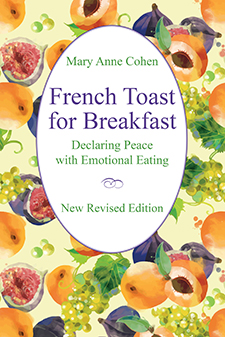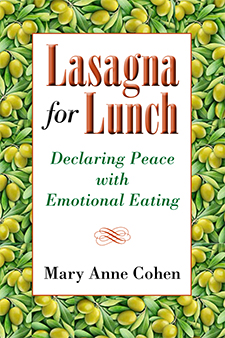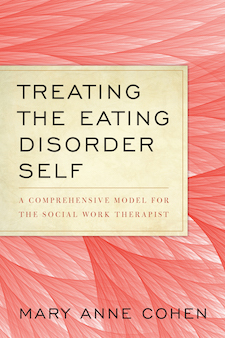Grief and Emotional Eating: Frozen Grief and Addiction Recovery
Patty was an obese binge eater who came to therapy to resolve her eating disorder. As we discussed what triggered her history of overeating and about her life experiences, she mentioned in a most casual that her father had died when she was four years old.
Her family told her, “Daddy went to Heaven. He is in a better place.” Daddy was never spoken about again.
“Tell me about him,” I asked. “There’s nothing to tell,” Patty replied. And with that, she began to cry as the accumulation of 32 years of stifled tears came surging up in a tidal wave of pain.
“Oh my God. I have never shed tears for my father before,” Patty sobbed.
With each following session, Patty cried deeply about the death of her father. Then one day she exclaimed, "I wonder if after so many years of not allowing myself to mourn my father, my fat has been like frozen grief. I think with all these tears, my grief is becoming liquid!"
Grief—frozen by fat, frozen by the numbing of overeating, drinking, drugging, or other addictions—can be held in the body for years and even decades. Patty’s description of “frozen grief” reminded me of a special moment I spent with my grandmother many years ago. Grandma was 86 at the time and was telling me about her father who had died when she was only five years old. To my astonishment, Grandma began to cry about her father’s death—a memory from 81 years ago! In that moment, I learned that grief has no timetable. Time does not necessarily heal all wounds. Unspoken loss continues to exert its power. There is no expiration date to memories or pain. I came to see how much loss and grief can play a significant part in the addiction behaviors and histories of my clients. And I came to see how therapy for addictions needs to help people mourn the sorrows that have kept them stuck in eating disorders, drugging, drinking, and other addictive behaviors.
I began asking my patients to construct a list of losses they had suffered in their lives. I discovered that these losses did not always have to do with death, but with a myriad of ways that hurt can lodge inside us without resolution. Unable to dislodge the “knot” in their throat by crying and grieving, many clients turn to addictive substances.
Walter came from a wealthy family with houses, a boat, maids, and a parade of nannies. He was alcoholic and bulimic since his early teens and, in spite of the family’s wealth, had his own list of hardships that he had never discussed or sorted through. He revealed: “Both of my parents were heavy drinkers and completely self-involved. My father died of alcoholism when I was 20.” Walter had suffered ongoing neglect from both parents, ruptures with different homes and nannies, and the traumatic death of his father. “Bulimia and drinking are all-consuming compulsions which has helped me ignore my hurt. When I’m not engaging with my substances, I’m very depressed.”
Mourning for what he did not have, for what he wished he had, and for what he never would have was bitterly painful for Walter. His bulimia and drinking provided a cocoon of deadness. Unable to connect with the rage at his lifelong deprivation, Walter could not move forward to mourn. With time, and with therapy plus a support group, he became more in touch with his great anger and sadness.
Feeling bad was actually progress for Walter! He was finally feeling rather than numbing. As he absorbed the ongoing companionship and compassion from his therapist and support group, the warmth of these connections helped him speak about his painful experiences and thaw his grief. The comfort of other people enabled him to relinquish the protection of addiction and embrace new possibilities of trusting and supportive relationships.
What Is Grief?
Grief is the normal and natural emotional reaction to any kind of loss. The symptoms of grief include guilt, crying, anger, depression, and anxiety.
Mourning is the process of sorting out these emotions. We experience, explore, express, and integrate our grief, finally adjusting and going on with our lives despite our loss. It is the inner process of letting go.
Mourning is not a linear progression of moving from point A to point Z and then we are done. Mourning has its ebbs and flows. It does not have a distinct beginning, middle, and end. Rather, it is like being lost at sea. Mourning can feel like an upsurge of hidden rip tides and strong ocean waves that can ambush you and knock you down by their sheer force. Other waves are like gentle memories lapping at your feet in a low placid tide making you smile with a soft sadness. Everyone’s grief and mourning are profoundly personal and unique.
Other Losses
Not only through death do we suffer grief that wounds our heart and soul. Any loss or change or trauma or transition in our lives can feel like a threat to our sense of stability and self. Many kinds of loss can trigger significant grief such as divorce, personal or family illness, abuse, work and financial problems, and giving up one’s addictive substances.
Why Do Addicts Freeze Grief?
Our culture is deeply uncomfortable with death, dying, and grieving, and we are encouraged to stifle our feelings. Mourners are advised:
God never gives you more than you can handle.
Keep busy!
Be strong!
Just give it time.
Time heals all wounds.
He’s in a better place.
You need to snap out of your isolation and start getting out more.
Keep a stiff upper lip. (I imagine that “keeping a stiff upper lip” is a person’s attempt to quiet the “trembling lower lip.”)
Frozen grief can best be described as grief on hold, partial grief, suppressed grief, complicated mourning, survivor guilt, and unfinished business. Sometimes, absence makes the heart grow frozen.
Addictive people, obviously, are not the only ones to freeze grief. But they are prone to derail, detour, and divert difficult feelings through addictive substances and behaviors. And grief is the most difficult of feelings!
Addicts believe if they open their hearts to feel their pain, it will never end. “If I ever started to cry, I would never be able to stop,” Yvette, an anorexic woman, declared. Simon, a recovering alcoholic, stated, “My Dad has been dead two months already. I should be over it already and shouldn’t really feel sad anymore.”
Yvette and Simon’s beliefs about grief reveal common traits of people with addictions: impatience with themselves, the conviction that strong feelings are scary and should be avoided, black or white thinking, and critical and perfectionist commandments to the self. Addicts prefer a “quick fix” rather than tolerating the process of digesting either substances or feelings. No wonder they turn to the numbing and anesthetizing substance of substances in an attempt to cover up their sorrow and anger and “just get over it.”
But grief is painful, it is supposed to be! Grieving is the process of untangling the loss of emotional connections to people or experiences that have great meaning to us. And that hurts.
Grieving thaws and mourning progresses when we can realistically perceive the good, the bad, and the indifferent of the person who has left us. Most people are a mingling of loving and flawed, wonderful and hurtful, kind and sometimes mean. Only when mourners are able to acknowledge the full range of attributes in the person they have lost can they integrate their memories in a way that will lead to genuine healing.
Unfreezing Grief: Restarting the Process of Mourning
No pain is so devastating as the pain a person refuses to face . . .
Glenn Schiraldi
Post-Traumatic Stress Disorder Sourcebook
When we are in pain, we naturally seek to protect ourselves from the hurt. And so, after a deep loss, people often sleep, drink, eat, shop, lose themselves on the computer, act out sexually, or engage in any number of activities to dull the ache and fill up the empty space within. But when addictions become an ongoing pattern and a way to chronically avoid pain, then grief becomes frozen. The substances quell the pain from the outside in, but real and lasting relief comes from unraveling our emotions from the inside out.
Healing grief does not mean you have forgotten the person or thing you lost. It means that the grief finds a place to live in your heart where you are enriched by loving memories and not tormented by anguished ones.
Grieving is ambiguous. It continues, it intrudes, it retreats, it pounces, it ebbs, it flares up, it settles down. Slowly we begin to learn to contain within us the contradiction that life does go on, there are still pleasures to be enjoyed, and yet we are forever altered by having lost and suffered.
The Process of Thawing Grief
The first step of thawing grief is to tell the story of your loss to safe and empathic people you trust. Sorrow needs to speak. Thawing grief includes:
- Recounting the story of what happened
- Describing the impact it had on you when it occurred
- Expressing the feelings of anger/guilt/self-blame/regrets you may have
- Imagining the effect this loss will have on your life as you move forward:
- Considering the connection between your loss and your history of bingeing, purging, starving, drinking, taking drugs, or any other addictions
- Remembering and re-experience the good memories, if any, connected to this loss
- Acknowledging the pain and hurt of the bad memories.
- Recognizing whatever unfinished business is connected to this loss. Accept the fact that your life does go on despite your loss and grief
- Making peace with the “new normal” that your loved one will always be missing
- Deciding to get help if depression/anxiety/self-blame/or any addictions are ruling your life
- Integrating a ritual or create a memorial, to honor your loss
- Cultivating other secure relationships, such as a support group or therapy, which will encourage you to take good care of yourself without the crutch of emotional eating
- Allowing yourself to feel the physical impact of your story:
Do you want to eat, drink, run away, or cry? Crying is our natural healing process of releasing emotions that well up. Tears are a gift from deep inside. “There is a sacredness in tears. They are not the mark of weakness, but of power. They speak more eloquently than ten thousand tongues. They are the messengers of overwhelming grief, of deep contrition, and of unspeakable love,” wrote Washington Irving.
Grieving the Loss of an Addiction
People often experience grief when they recover from their addictions because they are losing their best friend and enemy (their “frenemy”). Their substance has been a tried and true way of soothing themselves and coping with stress. In recovery, addicts also need to face the sorrow about how much time, energy, money in their “relationship” with their substances has consumed.
Eventually, through the process of healing, people need to part from their addictions, honor the help they have provided, and go their separate ways. This farewell does engender grief as the question remains: “Who am I without my addiction?”
Rose Ann has struggled with binge eating disorder, anorexia, and laxative abuse. In her poem, written as she emerges from the bondage of her eating disorders, she portrays the transition from an eating disordered identity to recovering the vitality of living. She captures the confusion, the hope, the vision of how life could be, as well as an acknowledgement of what it has been like living under the tyranny of an eating disorder.
Who Am I Without My Eating Disorder? By Rose Ann F.
Who am I without my eating disorder? I am just dirt on which you walk, Or am I the ground for which things grow?
Who am I without my eating disorder? I am the rose about to wilt, Or am I the bud who needs to bloom?
Who am I without my eating disorder? I am damaging thunder that brings the storm, Or am I the rain that brings the rainbow? Who am I without my eating disorder? I am the fire burning destructively hot, Or am I the flame that wants to glow?
Who am I without my eating disorder? I am the mouth that craves to eat, Or am I the lips seeking a kiss so sweet?
Who am I without my eating disorder? I am the tears that carry sorrow, Or am I the tears that set you free?
Who am I without my eating disorder? I am the heart that anxiously skips a beat, Or am I the pulsing rhythm in my feet?
Who am I without my eating disorder? I am the life that waits for death, Or am I the child still unborn Who waits first breath
To greet new dawn?
The more you run away from intense emotions, the more your addictions run after you. Grief must be witnessed to be healed. Therapy can help to unfreeze grief. You learn that your pain is not the whole of who you are. Tears thaw grief. Shared pain is soothed pain.
Food for Thought
To chronicle your own history of loss and grief, create a time line from birth to now. Include any rupture, disruption, change, loss, family death or turmoil, significant illness, accident, or violence that occurred to you.
Then, chronicle your time line history with your substance use/abuse.
1. Are there any parallels between these two time lines? Can you relate an upsurge of substance use to the times of loss or grief?
Doreen made an abridged time line and described it to me: “I actually made a graph of all the losses and changes in my life, then I superimposed my addiction history on top of it. Here is what I learned:
- When I was five years old, I was a normal weight kid. Then my parents moved into a house of our own in the suburbs. The photos after that move showed me getting heavier and heavier. I imagine I felt bereft to leave my little friends behind; they were the very first friends I ever had. My mother may have been more socially isolated in the new house because she didn’t drive, and my father had more financial responsibilities with the mortgage. I think the heightened anxiety level in my house began fueling my compulsive overeating.
- I had an abortion when I was 24. My guilt, confusion, and shame led to another upsurge of compulsive bingeing in which I gained 30 pounds and out of control drinking.
- When I was 40, my older brother was diagnosed with leukemia. As he became more emaciated, I went through a period of anorexia. Part of me really enjoyed the self-control of starvation. Brad died two years later, and my anorexia continued until I went into treatment. Treatment helped me to eventually start eating again, even though a part of me really prefers being anorexic to being normal. Just a part of me, though.”
2. If I open my heart to pain, what is my biggest fear?
3. What do I lose if I keep it locked up?
4. How does my substance abuse help keep my pain under wraps?
5. And, as Rose Ann’s poem asks, “Who am I without my eating disorder?”
Mary Anne Cohen is Director of The New York Center for Eating Disorders. She is the author of French Toast for Breakfast: Declaring Peace with Emotional Eating and Lasagna for Lunch: Declaring Peace with Emotional Eating.
Published by PsychCentral.com and TheFix.com



